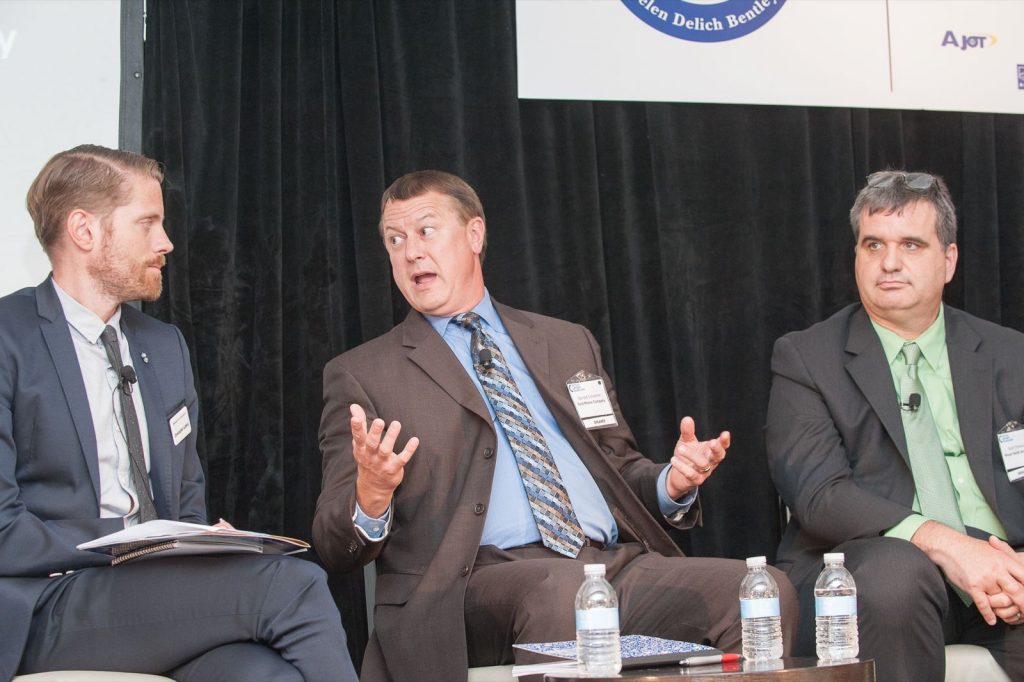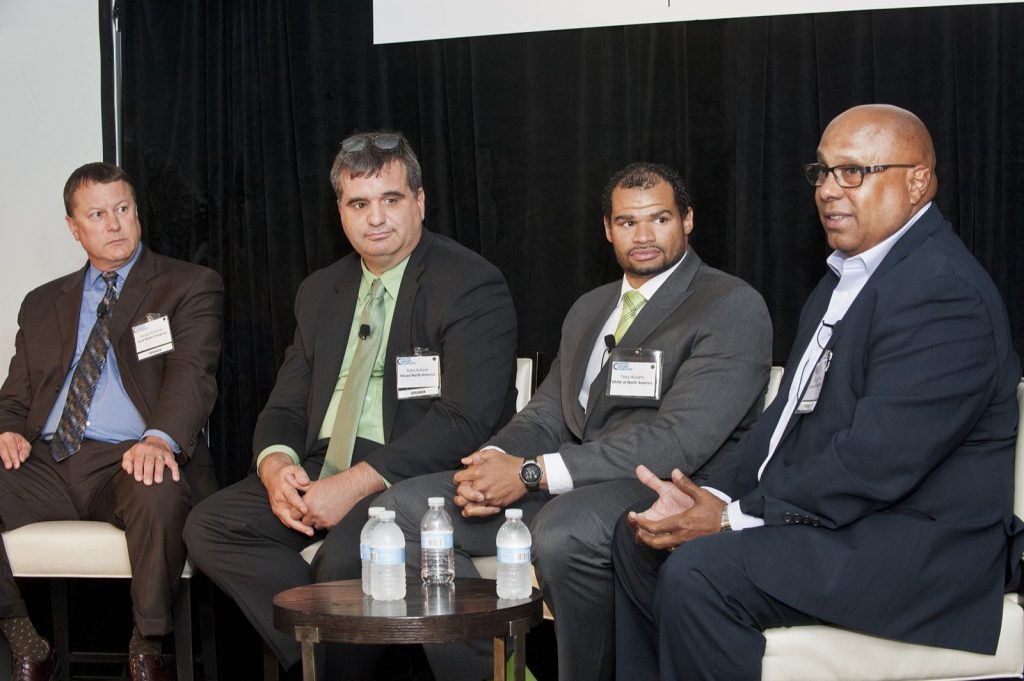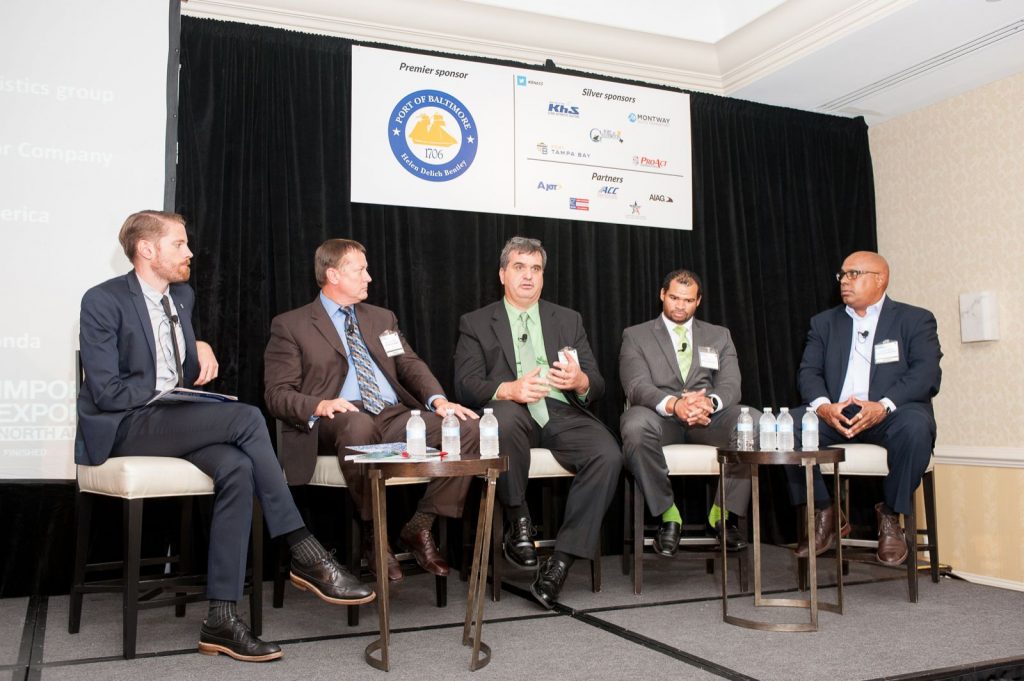This year’s Import Export North American conference covered a lot of territory, from managing changes in export and import patterns, new flows from Mexico, capacity limits and increasing safety and quality holds.
To close the conference, a panel of vehicle logistics executives from Ford, BMW, Nissan and Honda discussed their changing port and shipping logistics needs with Automotive Logistics editor, Christopher Ludwig, as well as the audience.
What would be the ‘X Factor’ in your supply chain, for import or export?
 Jerry Schoenle, director, Ford Trading Company, Ford Motor Company: In terms of our company’s headache, we’re expanding and becoming more integrated internally. As we do that, having our partners aligned with us will make the difference. We’re also looking at cash flow. We have realised we’ve got inventory hung up at different stages, and that’s the business case for a lot of work we’re doing. There’s customer satisfaction and cost reduction to consider, but it’s a big cost win when you reduce inventory.
Jerry Schoenle, director, Ford Trading Company, Ford Motor Company: In terms of our company’s headache, we’re expanding and becoming more integrated internally. As we do that, having our partners aligned with us will make the difference. We’re also looking at cash flow. We have realised we’ve got inventory hung up at different stages, and that’s the business case for a lot of work we’re doing. There’s customer satisfaction and cost reduction to consider, but it’s a big cost win when you reduce inventory.
 Scott Pollard, manager, vehicle logistics, Nissan North America: For Nissan, we’re seeing more go out by water and less come in. To go with what Jerry’s saying, we look at what port we go to based on cash flow. Some of our Chinese and Korean exports go out of Georgia, which looks counter-intuitive until you consider the cost flow. Our ‘X Factor’ is the number of days, including the days of transit, and how we’re trying to reduce those.
Scott Pollard, manager, vehicle logistics, Nissan North America: For Nissan, we’re seeing more go out by water and less come in. To go with what Jerry’s saying, we look at what port we go to based on cash flow. Some of our Chinese and Korean exports go out of Georgia, which looks counter-intuitive until you consider the cost flow. Our ‘X Factor’ is the number of days, including the days of transit, and how we’re trying to reduce those.
 Tony Abrams, VDC facility manager, BMW of North America: Our ‘X Factor’ is getting the product from A to Z and being the most efficient. We have a new VDC in 2016 from the port of Galveston because our market in Texas is so big. We’re looking at reducing damage with less long distance land transport from the east or west coast. We don’t see a high percentage of damage shipping to Texas, but the customer has a high expectation, and customer demand is very important.
Tony Abrams, VDC facility manager, BMW of North America: Our ‘X Factor’ is getting the product from A to Z and being the most efficient. We have a new VDC in 2016 from the port of Galveston because our market in Texas is so big. We’re looking at reducing damage with less long distance land transport from the east or west coast. We don’t see a high percentage of damage shipping to Texas, but the customer has a high expectation, and customer demand is very important.
 Charles Franklin, manager export logistics, American Honda: Our founding father was entrepreneurial, so we can run the company as we see fit. We have minimised some of the inter-activity, and partnered closer with the factory and other areas. We also need to focus on designing cars that can be shipped better, which will improve the whole process.
Charles Franklin, manager export logistics, American Honda: Our founding father was entrepreneurial, so we can run the company as we see fit. We have minimised some of the inter-activity, and partnered closer with the factory and other areas. We also need to focus on designing cars that can be shipped better, which will improve the whole process.
--
Will you use more short-sea services out of Mexico?
Pollard, Nissan: We’ve been using short-sea out of Mexico up the East Coast for 15 years. We were the only ones doing it for a long time. So many railcars terminate in California and/or Texas, and are then turned over to Mexican railroads, so we’ve never made a business case for the west coast. I think capacity will get stretched but we have enough warning and they will have enough time to supply the number of railcars needed.
Abrams, BMW: Mexico is a new venture for BMW. We have a strategy in terms of shipping and logistics but I can’t currently share the details.
Schoenle, Ford: We do some short-sea that we expect to grow going forward. We need to work out how you put together a back haul programme so it makes more sense and improves efficiency.
Franklin, Honda: One advantage of short sea is that it mitigates vandalism, which is an issue down south.
--

Schoenle, Ford: We’re seeing the most congestion at the first connection outside the port, primarily on rail. Once in a while we run into space situations, but that’s often our own doing because of launches, quality holds or uneven production.
Pollard, Nissan: We’re not seeing as much congestion on the export side, but we’re seeing shortfalls on the domestic regular transportation. The I-65 in Indiana was closed for 30 miles as a bridge was unsafe, so all our traffic to Chicago had to take a detour: that’s an extra 4-7 hours for a driver, and we lose some truck capacity. We know the bridges are falling down but we’re not doing anything about it. From an infrastructure perspective, I’m more concerned with roads. Once you get to the ports it’s fine.
Abrams, BMW: Overall we’re in a good place, but we are starting to see some congestion at ports.
Franklin, Honda: I don’t have any major difficulties with exports, except in the winter months with rail issues. That’s an ongoing issue and probably the biggest one. With the big move to Mexico, the ports are congested, and infrastructure is stressed. We have to focus on getting that strengthened up. I calculate how many cars aren’t going to make it, because the infrastructure doesn’t allow for non-stop steady transportation, and vehicles get mishandled.
Pollard, Nissan: If our export ports are congested, container yards are past congested. If a small widget from China is delayed, it can interrupt production. We don’t keep a lot of flow. Perhaps there’s more of an issue on inbound.
--
How well are your ports and logistics partners adapting to increasing exports?
Pollard, Nissan: I’ve got no real qualms with our exports. I know it will get loaded and be taken care of. Our steam ships are fine. I have concerns at the receiving ports. You have to deal with trade regulations and you can’t go through certain countries or ship through here. Internally, there are no big concerns, but externally, when you look at other countries, there are concerns.
Franklin, Honda: From an export perspective, I’m pretty happy with my processors. They’re my boots on the ground. If I call and say I’ve got a quality campaign, or bugs in cars, they’re the ones who handle it. One issue I do have – I don’t know if it’s mine or theirs – is that I’m trying to get consistent damage reporting. I need to know what is happening and where it’s happening. I’m not trying to point the finger, but we need to work together and stop it. It may be how we designed the car. If that’s the case, we address it. I’m responsible for the vehicles until the final destination.
On the export side, you don’t really get cars backed up. Where you do see back-up is on the import side. When cars come in in big bunches, it puts stress on the supply chain. If there’s a problem with a car, it gets fixed at the port and that slows down the release.
Abrams, BMW: The train never stops moving on production. They will build cars until the sky turns red. It comes down to communication between OEMs and processors and shipping lines, and I’m not sure there’s a solution.
--

Abrams, BMW: We used to let the dealer fix a lot but now we keep the car at the port. If it’s safety issues we have to hold it.
Schoenle, Ford: We prefer to get it fixed here than export the problem. Some markets have good PDI centres and some don’t. We will hold products, and it tends to be certain vehicle lines that have more issues than others. We’re coming from having done exports for a long time in small volumes. As the numbers grow, we and our suppliers are coming to grips with what that means: more volume, more repair capability, extra processing shifts... We don’t want to reach a choke point.
Franklin, Honda: Quality campaigns are not predictable. I just get a call to say, “hold them”, and have to partner with ports, processors and the factory to see how quickly we can get what needs to be done, done.
Pollard, Nissan: For exports, we don’t launch for two-three months until after domestic. We check we’ve got everything crossed and dotted. Imports we will hold at the port. Export we have very few quality concerns and flow stoppages.
--
How much sharing do you do with other parts of the world to share best practices and processes?
Pollard, Nissan: We share quite a bit of information between us and Mexico, and some between the US and Japan. Japan is a unique market with no rail [for Nissan], everything is truck. Europe is predominantly truck [for Nissan], but there is some rail starting. We have some common KPIs, and try to benchmark as much as possible.
Abrams, BMW: Among all the VDCs and distribution centres, we commonly share information weekly. Every year we do an international vehicle distribution meeting to share best practices, facilities, markets, quality damage, import targets etc.
Franklin, Honda: With Mexico, we export all their vehicles and have a weekly teleconference with them. I get daily reports and visit Mexico around once a month. For Canada we manage their exports but it’s not the same volume as Mexico. We communicate well regionally and globally not as much.
--
Are you looking at new regions, areas, ports, or changes to your network?
Abrams, BMW: We’re not looking at immediate changes, except for the new port in Texas. We’re also looking to expand to additional VDC on the west coast in northern California since west coast import sales have grown and Hueneme is at capacity. We need to look to the long-term, and can we build a VDC hub that will take some of the volume.
Schoenle, Ford: Looking at or numbers we know we’re going to need more. The book is open and we’re looking at a few different potentials. The overseas markets are in the conversation with us and requesting more ports.
--

Schoenle, Ford: When you have a glitch or something you have to address, it’s all across the network. There’s a lot of communication, and a lot of time needed. That’s the downside of a wide market offering. We’re living that in certain cases.
Pollard, Nissan: We limit the number of variants we send. For example, in some places we have colour variation and that’s it.
Franklin, Honda: If we have lots of products realised it means we’re competing. There will be something, perhaps as simple as the wrong language on the mirror, but it’s still an issue. It’s like a puzzle, logistics touches more of the company than most divisions realise. We have to get it, fix it, and it’s gone.
Abrams, BMW: A simple label can hold a car in the US market. Our factories send the plant person for the first few weeks of plant processing and additional quality checks. There are differences in weather and heat, so it’s good to see how a car arrives and is handled.
--
How do OEMs assign inventory carry costs for finished vehicles?
Abrams, BMW: BMW doesn’t charge the dealer for a plan until the vehicle leaves the distribution centre. If we want to ship ten more vehicles, it’s built into the cost of the car.
Schoenle, Ford: For us it depends. If it’s held for a few days then the dealer carries the cost. For North American exports, it stays on the books. We’re in weekly discussions with the head of manufacturing and the controller for North America to track that inventory on a regular basis.
Pollard, Nissan: For export we transfer ownership once it’s over the rail. As far as domestic goes once we tender a vehicle to the carrier, it belongs to the dealer.
Franklin, Honda: For export there’s an average that’s built into the cost of the vehicle, included in shipping cost.
--
Does the supply chain need to be more transparent?
Schoenle, Ford: We know where a vehicle is at any given time but how it’s going to progress and how to accurately make that estimate is more difficult to predict. We want to tell the customer but we want to promise something we can deliver on a regular basis. Across our network our standard deviation is too wide.
Pollard, Nissan: We can track domestic vehicles – obviously we know if they’re in the yard or not. Once they’re on the rail we can track by VIN. We can work out averages, and we know it internally, but we’re hesitant to give the information to a dealer. If there’s an unforeseen circumstance, such as a bridge getting washed out, or train derailment, or locusts, the time can increase more than we predicted.
Abrams, BMW: We know where inventory is down to the VIN through whatever port of entry. We have an ongoing project in Munich to use real-time tracking, telematics within the vehicle... that’s something we may use internally. We want to ensure customer satisfaction, and not annoy a customer by giving them an ETA that isn’t 100% accurate.
Franklin, Honda: We focus primarily on the vessels. We have a shipping plan that we share based on the production schedule. Once it’s on the vessel however, I can’t manage that.
--
Do you see the potential to make use of data from connected cars?
Schoenle, Ford: A lot of these systems have to boot up the vehicle to send the signal. If they’re floating for three weeks, booting up all the time, by the time they arrive the battery will be dead. It’s clever and fun but only when it’s useful. There’s no point when they’re all on a vessel, but once they divide up and hit the market and they’re on a truck, that data could be really valuable. The capability would be there quickly, but figuring out the right way to use it is the issue.
Pollard, Nissan: Japan to the East Coast is 42 days and it could be an issue to be pinging information all that way. I just don’t see us going that way though.

























![Global[1]](https://d3n5uof8vony13.cloudfront.net/Pictures/web/a/d/s/global1_726550.svgz)









